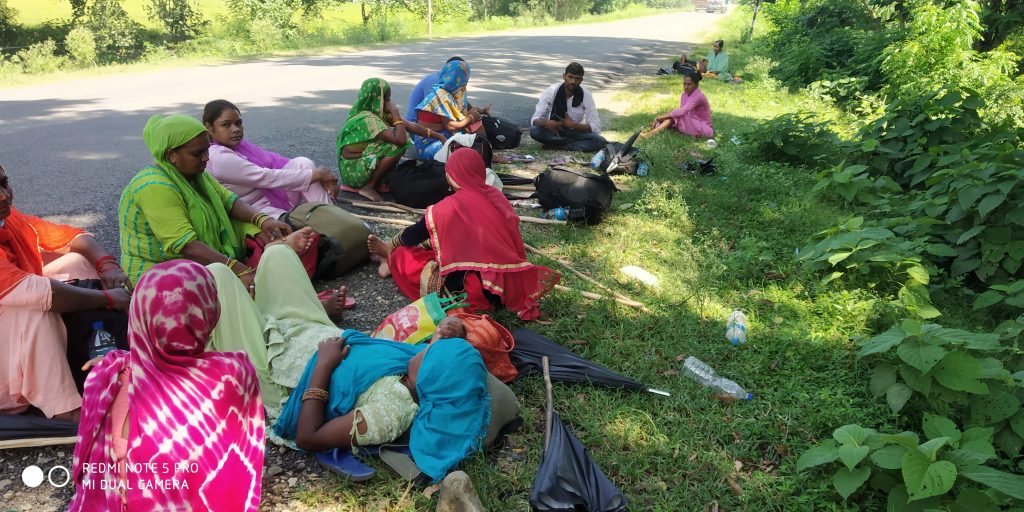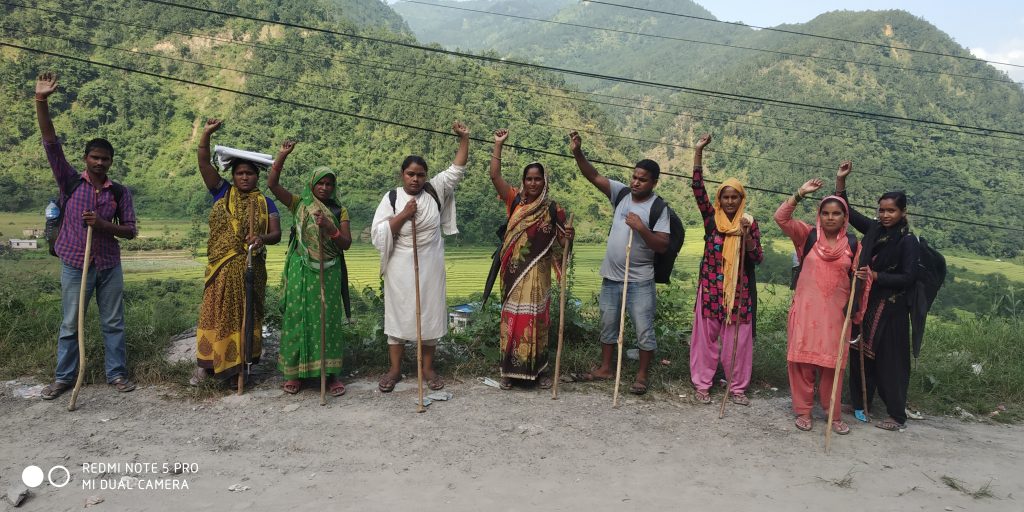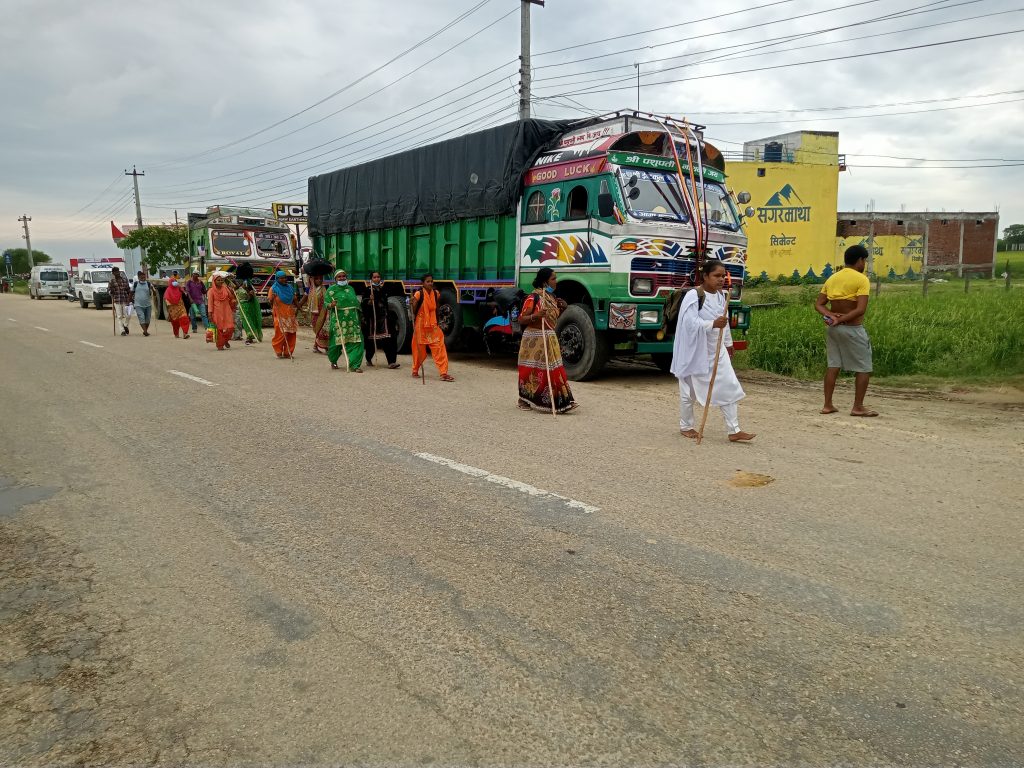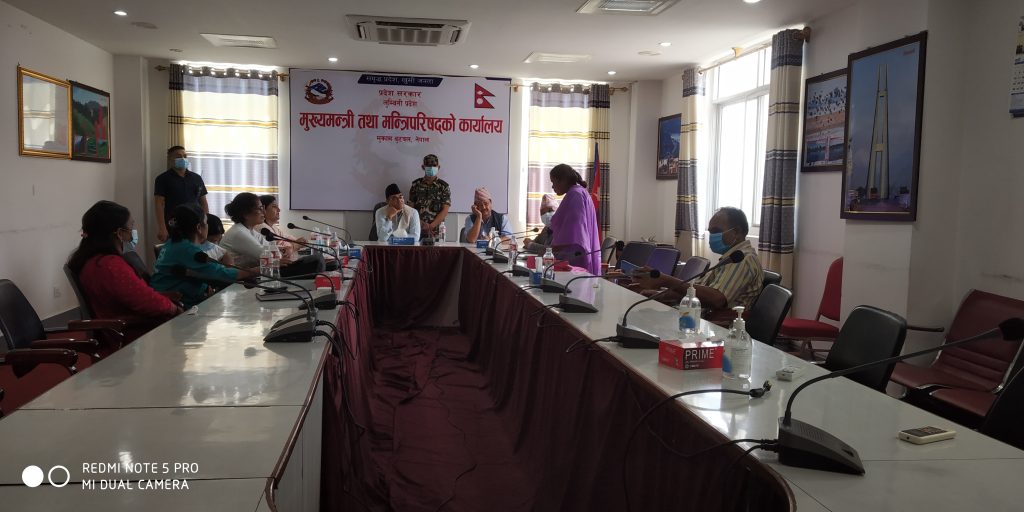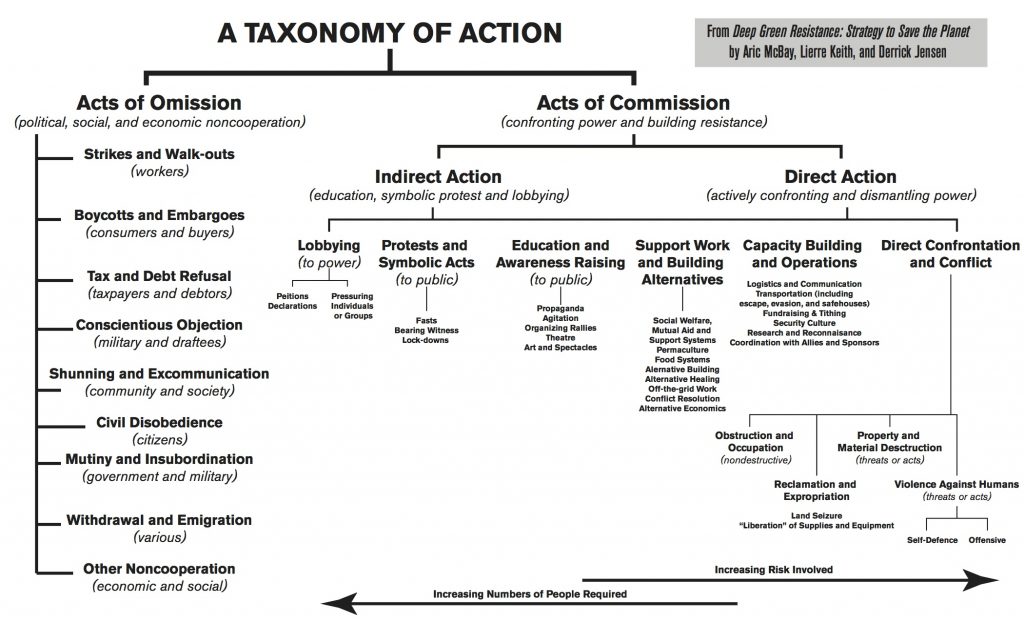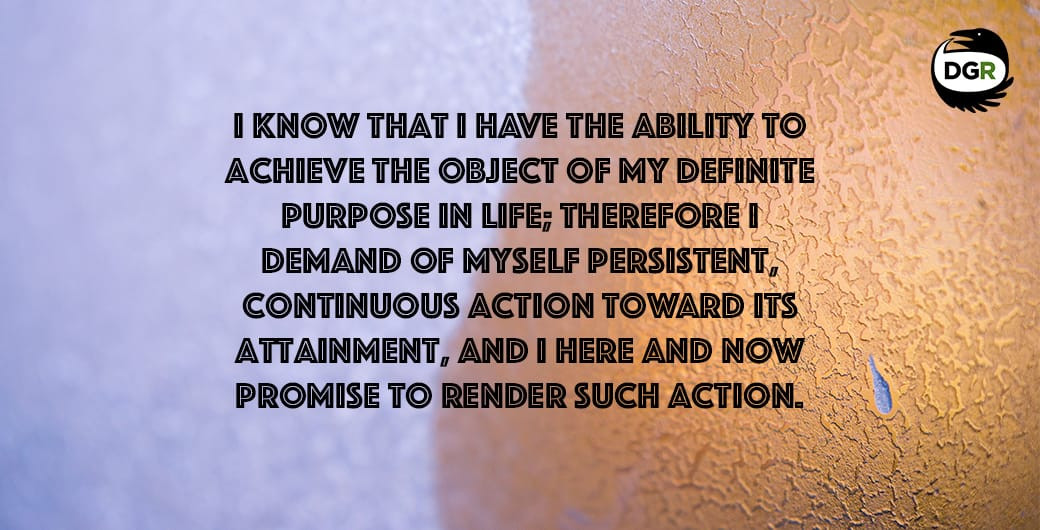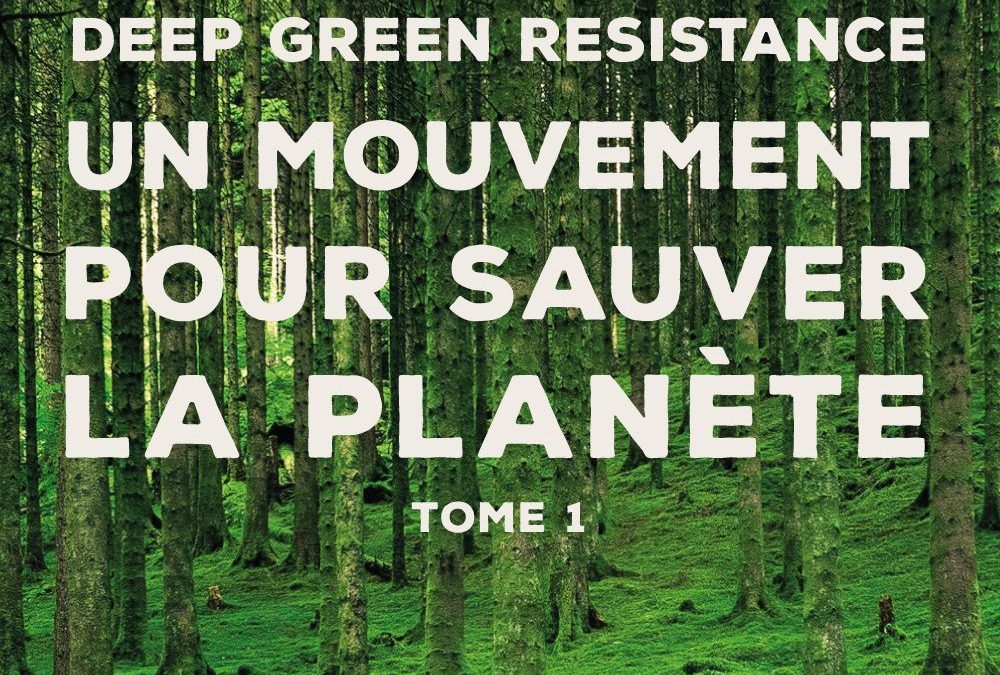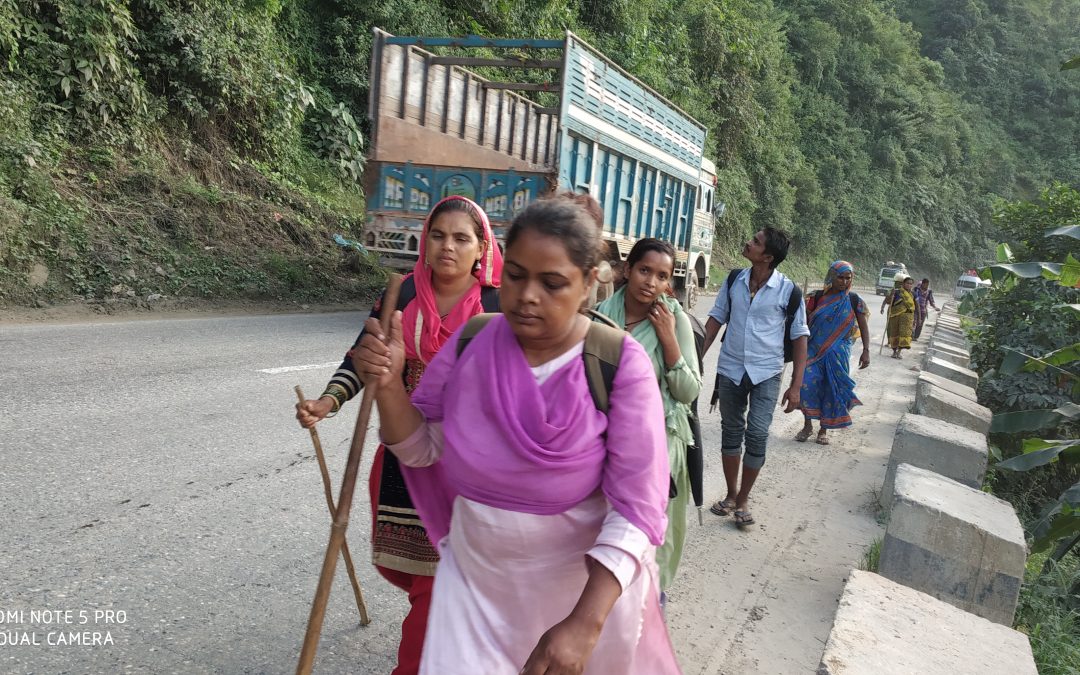
Rural Nepali Women March 520km to Protest Violence and Sexual Abuse
Editor’s note: In Nepal, as in many parts of the world, male violence against women is relatively common, yet often goes unreported and unpunished. Today we bring you an interview with Ruby Khan, a working-class Nepali woman who marched 520km (320 miles) and helped launch a grassroots uprising for concrete policy and cultural change in response to two incidents of violence against Nepali women.
As an eco-feminist organization, Deep Green Resistance recognizes the links between the destruction of the planet and the oppression of women. Not least importantly, when women have greater autonomy and control over their lives, they chose to have fewer children, on average. Therefore, the liberation of women is not only the right path to justice, it is a necessity for reversing population growth and defending the living planet.
More broadly, the same philosophical roots underpin both patriarchy and the destruction of the planet, which creates the potential for synergistic positive effects when addressing these issues.
This interview, conducted by DGR organizer Salonika in Nepal, gives us a fascinating glimpse into the discipline, sacrifice, and hard work that goes into grassroots organizing.
It took 16 people 20 days to cover the ~520 km from Nepalgunj (a city in south-west Nepal) to Kathmandu (the capital city) on foot. With feet swollen with blisters from the mostly uphill march but determined to ensure justice for two women (Nirmala Kurmi and Nankunni Dhobi), the group started their first round of demonstrations in the capital, including a 12-day “fast unto death”, demanding proper investigation into the cases of the two victims of male violence. Finally, the government agreed to form an investigative committee and requested time to fulfill any ensuing recommendations.
This committee was formed under consisting of six members – five from the government and one from the protesters. The committee completed their work within seven days with a report that included recommending a Central Investigation Bureau (CIB) investigation for one of the cases.
Two months after the committee had submitted their report, the group was forced to travel to the capital again because the government had failed to follow through on the committee’s recommendations. After 41 days, the government developed a four-point agreement to address their demands. Following the successful second demonstration, DGR organizer Salonika interviewed the leader of the group, Ruby Khan, about her journey, her work, her movement and the cases that inspired it. The following blog post is based on that interview.
“During our journey, we became so involved with Nirmala and Nankunni’s lives that we felt like the two of them were walking beside us. That feeling of being close to them inspired a hunger for justice. We knew that it would not come easily and that it required courage.”
— RUBY KHAN
Who is Ruby Khan? What does she do for women and girls?
I am Ruby Khan. My hometown is Nepalgunj. I work with women in Nepal who have been victimised. My goal is to help them get out of the violent situation and to help create a safe and secure environment for them. This is what I have been working for in the last decade.
The group marched for 20 days to reach the capital and returned after agreement was reached. Why did they need to make that journey?
I work with women in Nepalgunj who endure violence. They do so in silence most of the time. When they muster enough courage to finally speak up, no action is taken. It is not that the state is unaware of the injustice women are forced into. When we talked to the Chief Minister of Lumbini state and the Minister of Home Affairs (separately), they both admitted that they knew about our case beforehand. The media started covering us from the first day of our march. By the second day, even the bus drivers on the highway recognised us.
The state is feigning ignorance. Our march was a symbolic action. There were times in the feudal era where people had to walk to the capital to meet the kings to report any injustice. Our march symbolises the same hardship. We travelled to the capital to let the state know about the injustice women and girls are facing in the peripheries of Nepal. It is to let the state know that, in terms of justice, the peripheries of Nepal are still in a feudal state.
Why did the group travel to Kathmandu again, merely months after their return home?
We had reached an agreement with the government after our first round of protests. But the government did not fulfil their words. That’s why we had to return. This time, we demonstrated in Maitighar Mandala for 41 days before we reached another agreement.<
Although your fight is for all women and girls who have been victims of violence, the focus of the current movement was on two specific women: Nirmala Kurmi and Nankunni Dhobi. Who were these two women and what happened to them?
Nankunni Dhobi was a victim of domestic violence. She felt unsafe in her own house. Her husband and brother-in-law had repeatedly encouraged her to commit suicide. They brought ropes and pesticides to her so that she would kill herself. She had repeatedly complained about her situation to the Women’s Rights Forum and to the police. Succumbing to the regular torture she felt from her in-laws, Nankunni finally took her life. But it was her husband’s instigation, the indifference of the police and the unaccountability of the state that killed her.
Nirmala was a wealthy but uneducated widow with immense property – enough for two or three generations. Ultimately, her wealth became the reason for her torture. Her two sons died under mysterious circumstances. No proper investigation was conducted in that regard. She herself was abducted, raped by multiple men and killed. Her property has been stolen.
What has the state’s response been to the two cases?
Both women had contacted our organisation when they were alive. We worked with them then and after Nirmala Kurmi’s disappearance and Nankunni Dhobi’s death. The state’s response has been dire in both cases.
In Nankunni’s case, when we – women’s rights activists and her family – tried to file a complaint in the District Police Office, the police refused to report the incident. Furthermore, the Superintendent of Police (SP) and Deputy Superintendent of Police (DSP) of Banke Police threatened to file a false case against us and take us into custody.
In both these cases, the state has acted irresponsibly. Its mechanisms are not women-centred or women-friendly: women’s issues are never at the forefront. The state is supposed to look after its citizens and uplift them for a better life, but it has failed women in that regard.
With respect to women subjected to violence, the state is supposed to remove victims from their situation and give them security. Instead, the state turns its back on women. If a woman tries to speak up, she is silenced. They feign ignorance about women’s plight, and that is used to excuse the inaction of the state.
After the first phase of our movement, the government promised us in writing to form an investigative committee for these cases, which they did. The committee submitted a proposal within seven days. However, their recommendations were not fulfilled. They recommended delegating the investigation of Nirmala’s case to the CIB. Because we don’t trust the SP and DSP of Banke, we believe the CIB would carry out a better investigation. But the state is yet to send a CIB team to Nepalgunj.
This is common practice by the state: under pressure, they will promise action. Then they will take token action but not do anything substantial. Particularly in terms of human rights violations, we need a justice-centred approach. We need an investigative approach. Unless we question the state’s inaction and unaccountability, we cannot have a justice-centred approach.
Does the state respond in a similar manner in other cases?
The state’s response is determined by a number of different factors. First is the position of the perpetrator. If the perpetrator does not have access to wealth or to political power, the investigation and the judicial process happens in a timely way. But if the perpetrator has access to power and wealth, the entire process changes. The state’s behaviour in such cases is one of inaction. The state administration is driven by greed on such matters: how can the person in charge personally benefit from the case? It may be via money or by taking advantage of the political influence of the perpetrator.
In this way, our institutions are more perpetrator-centred than victim-centred. When the perpetrator has access to financial and political power, they are prioritised over the victim. Their statements are treated as truth without verification. Even when the case is sensitive and serious, the administration treats the incident as standard, undermining the gravity of the crime and focusing on resolving the case through a settlement instead of through the judicial process.
The reason that Nirmala Kurmi’s case has not reached the court is precisely that. The primary accused in her case is a man called Badshah Kurmi, who is a distant relative of the victim. He is also a member of the current ruling party and has served as a parliamentarian. He is an immensely powerful person. On the other hand, Nankunni Dhobi’s accused are not as powerful. They are not immensely rich. We still had to fight on her behalf, but eventually her case was filed and her accused are now in custody awaiting the court’s verdict.
Nirmala and Nankunni are very different from each other and so are their cases. Apart from both being women and powerless, there is little similarity between the two. Nirmala was wealthy, but Nankunni was not. The violence that Nirmala had to face was drastically more severe than that faced by Nankunni. Multiple different heinous crimes were committed against Nirmala.
It makes more sense for the state to be more serious about Nirmala’s case, but that has not happened. Nirmala’s perpetrators are powerful and that has hindered justice. Even during investigation, the District Public Attorney released Nirmala’s accused from custody under the pretext of age. And in other cases I’ve seen the Public Attorney take eighty-year old accused under custody. It is not the age of the accused, but rather his influence that has gotten him out of custody in this case.
At the same time, the police themselves have destroyed evidence in Nirmala’s case, planted false evidence, and are using evidence brought by the main accused as the primary evidence It is not that the involved authorities are incompetent: I’ve seen them work diligently to bring justice in other cases. But that has not happened in the current case. It is because the accused are using their financial and political power to manipulate the process. The District Police Office and the Public Attorney of Banke are gaining politically or financially from this case. The different treatment of the cases of Nankunni Dhobi and Nirmala Kurmi demonstrates the role that power plays in deciding justice for the general public.
What about the victims? How do they get treated in the investigation process?
In a twisted role reversal, the victim is treated as the culprit. Their statements and character are questioned much more than the perpetrator’s. They are told that the court process is very stressful and reminded of the stigma associated with it. Women are even told that it was in her best interests to have remained silent, and that being a woman, she should have tolerated a few slaps. They are also reminded of the perpetrator’s power. All of this destroys the victim’s courage: they begin to question their decision and even change their statements. They decide not to seek any further action, which is exactly what the perpetrator-centred institution wanted.
The situation would have been slightly different if the victim had been a male. A man’s words are not as easily dismissed as a woman’s. A woman is accused of backtracking on her statements, even though it is the police and society’s reaction that have forced her to do so, and then the police generalise that to all women. They start with the assumption that women are unreliable, and that’s the bias they hold throughout the entire process. This hampers the investigation process. A man cannot be as easily accused of being unreliable. When a man complains, his words are given a certain weight.
But there are class differences as well. If the victim is from a wealthy family, his complaint is immediately registered and the investigation process starts. However, if he is not wealthy and the perpetrator is, the victim may be pressured by the police to settle the issue. The victim goes through the same process of fear, regret and worry about social disgrace. He begins to justify the violence he faced in terms of class differences. The next time he faces violence, he does not try to file a complaint.
It seems to me that how the police deal with a case is entirely dependent on the power hierarchy. Violence by the powerful (male, wealthy, access to political power) against the powerless (female, poor, no political access) has been normalised in our society, and even law enforcement agencies accept this. However, violence by those without power against those with is not tolerated: immediate action is taken to punish the perpetrator and ensure the victim’s security. But immediate action to ensure the security of the victim should be the right of all, even if they are at the bottom of a power hierarchy.
When it comes to state action, the main questions are: what power does the perpetrator have and what power does the victim have? At the same time, we must remember that a powerful person cannot be victimised in the way a powerless person is. It is always the powerless who are victimised. Their human rights are violated. On the other hand, the perpetrator’s human rights – due to his greater access to power – are protected by both state and public institutions.
Class prejudices mean that a woman of a higher socioeconomic class is less victimised than a woman of a lower one. Her economic resources give her greater access to opportunities, including education.
Education itself creates another hierarchy. When a woman is educated, even if she is poor, she is aware of her rights. She knows the laws, and where to go if she becomes a victim. This gives her greater confidence. Statistics show that a lot of crimes are committed against the uneducated. This is because uneducated people lack information about their rights and about the steps that they could take should someone violate them. In this way, they are forced to tolerate whatever happens to them, and thus they are an easy target for the perpetrators.
Who were the 16 marchers who made the arduous journey?
The marchers were mostly rural women from Terai, both Muslim and Madhesi women.[1] I’ve been involved in activism for about a decade, but most of the women involved in the march had had a very limited public life. They were mostly limited to their homes, their parents’ homes and the marketplace. Walking to Kathmandu was something that they had never expected to do: at times they were scared, and at times they were amazed by a world that was so different from theirs. In their daily lives, they would have had to ask permission from their husbands to visit their parents. They thanked me because their husbands would otherwise never have let them embark on this journey, and they were grateful for the different experiences.
There were only three men in our group. They were all rural men: they did not know a lot about the system or society. They had never left their village in their lives.
Three people joined us after we reached Kathmandu: they had not been able to walk with us due to various medical conditions. Five more joined us on our second journey.
Five hundred kilometres is not a short journey. To inspire 15 others to make the journey by foot is an entirely different thing again. What difficulties did the group face during the march?
We started the march on Asoj 1 (September 17), and it lasted till Asoj 20 (October 6). Our march was one for justice. It was a very difficult journey, but it was also a journey of courage. Knowing what we suffer in the pursuit of justice and what women have to suffer strengthened our commitment and gave us the courage to tolerate hardships.
Our journey was not just difficult, it was risky as well. Before we left, I said to the group, “We are starting as 16 people, but we don’t know how many we will be by the time we arrive: we don’t know who among us will survive the march.”
We walked through landslide-prone areas; we heard rumours about tiger attacks; we were chased by snakes. We were scared.
For most of the journey, we walked on highways. The roads were never empty for even a minute. All kinds of vehicles sped past us. On one side of the road were big hills, and on the other was a deep fast-flowing river. One misstep in one direction and we would have fallen in the river; one misstep in the other direction and we would have been run over. Sometimes we cried from fear.
On top of that, we were also scared of being victims of violence ourselves. Our group were mostly women between 20 and 45 years old. We had to face all the fears that haunt women. We were scared somebody would attack us. Twice, some drunkards tried to talk to us and to walk with us. There were others who would offer us rides on their scooter, but we knew they were not trying to help us. They would not leave us when we refused. And we knew that they were behaving that way because we were mostly women.
And we didn’t have enough to eat. We remembered all the food that gets wasted every day. We learned the value of a single grain then. There were times when we had to miss two or three consecutive meals. We used to pray that we would meet someone the next day who would feed us till we were full. There were times when I told the group that whenever they got a chance to eat, they should eat as much as they can, because we just didn’t know where our next meal was going to come from.
There were times when we would be so thirsty that our lips would be so dry that they would stick together when we tried to speak. Occasionally, we would find streams of water flowing from the hills. Those streams were so precious to us. Even now, I can taste the water. Back home, we wouldn’t think twice before wasting water, but during the march, we realised how significant water actually was, and what happened when we didn’t have enough to drink.
Sometimes we had to sleep on the road, where we were at risk of being run over by passing vehicles. We were so tired by then that even the hard stones became soft mattresses for us. Sometimes we would cry, missing our mothers, who would have fed us and gotten us to sleep.
Given all this, how did the group find the courage to complete this journey?
We started the march due to our hunger for justice, which was stronger than our hunger for food. It was so strong that while we were walking, it seemed as if our legs were walking by themselves. That was true for all of us. No one said once that it was getting too difficult, that we should probably return. Our hunger for justice could not be satiated with food, money or anyone’s support. It could only be satisfied with the confidence that someone would protect us.
Even now, our hunger has not been satisfied: we are yet to see how the latest agreement will be implemented. After the agreement, some of our friends told us that hopefully, we would not have to return to Kathmandu again. We told them that until our hunger for justice is completely satisfied and the perpetrators are punished, we will keep returning. Justice is an experience. It’s not something you can see. It’s something you have to feel.
During our journey, we became so involved with Nirmala and Nankunni’s lives that we felt like the two of them were walking beside us. That feeling of being close to them inspired a hunger for justice. We knew that it would not come easily and that it required courage. To overcome our fear of big hills, we used to say that our courage was bigger than the hills in front of us. We held each other’s hands while we walked and sang to distract ourselves from hunger. Four or five of us were close to dying. Yet, we survived all of that. It was our sense of justice that gave us the courage to face all of that.
Some of the women in our group had medical issues. But during the march, they said that they felt their health was improving. We checked their vitals on the road sometimes, and they turned out to be in the normal range. It felt as though nature herself was supporting us.
We used to have long conversations while we rested. We would talk about our lives, our joys and our sorrows. We tried to understand each other’s lives. Some women cried during these conversations. They talked about things that they had never told anyone else, things they had kept to themselves for years. They felt understood for the first time in their lives and thanked us for this. Usually, nobody listens to women, not even their husbands. They would dismiss a woman’s feelings and thoughts. When the rest of the group actually listened to those women, it was a big deal for them. They felt supported. They felt understood.
No one ever complained that they wanted to return. In fact, some even offered to carry others when they seemed sick. This shows that if one wills it, anything can be done.
The group met a lot of people on their journey. What responses did you receive?
We met different kinds of people. Some were very supportive of what we were doing. They would offer all the help that they could. Some told us to return: they said that Nirmala Kurmi and Nankunni Dhobi were dead and the state didn’t care. They added that the state wouldn’t care if we all died, and that we shouldn’t risk our lives for that. They even offered us the bus fare to return home. We could see that they were concerned for us. Some cried for us: it was too difficult for them to see our suffering. We were in pain. We had blisters all over our feet, and it was difficult for them to see.
Others would encourage us to carry on. They said that it was necessary. With all the violence that was going on, the rapes that were happening daily, the abuse, the domestic violence, it was necessary to take a drastic step. Women were getting murdered. They said that our step would force the previous generation to consider what was happening and the next generation to learn. They said that we were creating history, that our children would learn that women made this long and arduous march for justice, and that it would be a source of inspiration for generations to come.
There were many more who showed their support. People learned about us through the media. They waited in their homes for us. In today’s society, it is difficult to find people who are willing to do anything for others at their own expense. Yet here we met people who were doing exactly that. Near Galchhi, we met an elderly woman. She offered us food, but we had eaten not long before. When we told her that we couldn’t eat, she offered us water, saying that it was the least she could do.
Even the police showed their support. We know that there are police who wronged us, but not every police officer is like that. It pained them to see our struggle. There were some who walked with us for the short distance that they were allowed. Some urged us to request security from their seniors so that they could walk with us. They showed their support in so many ways that it was a source of courage for us.
How was the group’s experience in Kathmandu?
In Kathmandu, demonstrations were more difficult than in Banke. Few of us had been to Kathmandu before. The first time we arrived, we were not in a good state. We had blisters all over our feet. The second time, the weather was very cold and we had to walk in the rain for a couple of days. It was so cold that it was difficult for us to hold our banners. The wind was so strong that it felt as if with every step, the wind was pushing us backwards. All of us fell ill; 14 got extremely sick and we had to seek medical help.
Did the group receive any support in Kathmandu?
We received support from those who cared about justice. We didn’t even have to call them. They found out about us and came to support us of their own accord. Dr Govinda KC[2] is an example. He was working in Rukum, but he joined us, leaving his work until we achieved justice. He came to support us because he was moved by what we were going through. He is not even an advocate for women’s issues, but he could see we were fighting for a just cause and that we ourselves were being treated unfairly.
Advocate Mohana Ansari[3] is another example. She has supported us in both a personal and professional capacity. She repeatedly warned the government to stop harassing us. For that she has received multiple threats. When I found out about this and asked her about it, she said, “If the fight for justice had been as easy, you wouldn’t have to walk from Nepalgunj to Kathmandu. This is a very small thing compared to what you had to go through. What’s more important is that we cannot afford to lose any more Nirmala Kurmis and Nankunni Dhobis.”
The list is long. A lot of other civil rights activists came to support us. There were students who would come directly from their examination hall to our demonstration site. They would skip a meal or walk instead of taking the bus and donate that money to us. We know what value money has in a student’s life, particularly those students from different parts of the country who come to study in Kathmandu. This shows their commitment to justice, and that we don’t need to call people to our cause. They join the fight if they are really interested in justice.
But we failed to garner interest from those we were hoping for: women’s rights activists in Kathmandu. When we first reached here, I contacted many women’s rights organisations for support. There was so much they could have done. The day we reached here the second time was the first day of a 16-day campaign protesting violence against women, for which many organisations were organising 1-day events. The cost of their 1-day events could have covered our expenses for 41 days. If, like the students, they had used that money to support us, it would have been a great help. If they had organised their events near our demonstration site, instead of in expensive venues, it would have helped us gain a lot more attention from the public. Many of the organisations have a shelter here in Kathmandu. We asked if we would be able to stay there, but they made various excuses. If they had only let a few of us stay, it would have considerably reduced our expenses.
The way I see it, they are not interested in justice at all. I’ve seen their work here. They are more interested in events that can be shared on different platforms. It is not that publicly sharing what you do is wrong. But most are interested only in that. They don’t even care if their events are effective, let alone about justice. They are content with sharing pictures of their events on social media and getting news coverage. This helps their public relations and can be used to gain further donations for similar events. And so on it goes. Since what they are doing is not really challenging the status quo, they don’t have to face as many obstacles. Those who are actually demanding justice are questioning the status quo and they face many challenges.
What was the state’s response to their movement?
When we started marching, we had hopes that the state would address us before we finished. With every step we took, that hope faltered. Yet we still expected the state to address our issue because that’s their responsibility. When Dr KC went to meet the Prime Minister with his own demands, he included our cause. At that time, the Prime Minister very clearly acknowledged all the trouble we were going through and promised that we would be sent home very soon. But a week passed without any progress.
The state did not show any concern for our movement. We were rural women who came from marginalised groups. We didn’t have much power. Plus, the mainstream women’s rights activists – who had relatively more power in terms of reach to both national and international platforms – were not supporting the issue. We came from the hottest place in Nepal and the weather of Kathmandu was getting colder by the day. Therefore, the state did not expect us to last long. They thought we would soon tire and return home. In fact, they wanted to tire us. But then civil rights activists – who had greater access to national platforms – got involved. Dr Govinda KC got involved. The media covered us and this created pressure. It was only then that the state showed any concern. On the 39th day of the second demonstration, government officials came to our site to get clarity on the issue. We used to reach the demonstration site by 10 in the morning and leave after 5, but it took 39 long days of hardship on our side for the state to finally want to “get clarity” on the issue. And that was after the Prime Minister had already verbally promised Dr KC that our demands would be addressed.
Our hopes for a positive response from the state had already died, but we had never expected the state to be so insensitive to the case. The first guardian of the nation, our President, is a woman. She did not show any interest in our issue. Our second guardian – the Prime Minister – went back on his words to help us. Because of this, we were forced to take another fast unto death. All of the women were willing to take the fast, but many of them were taking regular medication. We therefore decided that only I would take the fast, but that we could reconsider it depending on how the situation developed.
News of our fast unto death attracted the state’s attention and constant pressure from other activists forced it to take action. We were called for a dialogue within the Ministry of Home Affairs. Even then, there seemed no real urgency on the state’s side to take any concrete action. It was only when Dr KC announced that he would join our fast unto death that the state finally agreed to ask the CBI to investigate the case. The most important aspect was that we got their statement in written form, which is very rare and holds the state more accountable. What had not happened in 40 days was completed within two hours. This shows that it is not the validity of a demand that brings action, but applying pressure in the right way.
Meanwhile the families of those involved in the movement are being threatened by the accused.
It is a very risky situation. We are not safe from the police, the accused or their relatives. Badshah Kurmi went to our homes to threaten our family that they would hurt, abduct, or frame us, as well as threatening our families themselves with violence. Since we are mostly women and, comparatively, women are more attached to their families, it is easier to threaten us by getting to our families. They have said that because we are not as wealthy as them, our voices will be lost.
Our relatives are calling us, pressuring us to end this. They believe that the accused could harm them. But we are not going to let this stop us at any cost. Since we are mostly women and comparatively, women are more attached to their families, it is easier to threaten us by getting to our families.
We have sent applications to the District Police Office and District Administration Office regarding those threats, and we also mentioned them during our discussion in MoHA. They have said that they will send a letter to related offices for our security. The letter has probably reached there by now.
Why did the movement create a division between women rights’ activists?
There is a division between women rights’ activists in Nepal. We are not mainstream activists; we are marginalised activists. Not only do we come from marginalised groups, but also, even in our activism we have had marginalised roles. Mainstream activists do not accept us as women’s rights activists. If Gita Chamar – a widow from a marginalised area – becomes the face of the women’s rights movement, it will hamper the reputation of those who are currently the face of the movement. Their authority as champions of women will be challenged, and this fear has stopped them from helping our movement.
Our point is that they need not have supported Ruby Khan’s movement. But as women’s rights activists, they should have supported justice for Nirmala Kurmi and Nankunni Dhobi. When we first arrived in Kathmandu, I asked them to take the lead in this movement. Because who leads the movement should never be the focus: it should always be about the cause. This movement was never my movement. It has always been for the justice of two women who were subjected to brutal violence.
On top of that, what the mainstream activists are currently doing does not challenge the status quo. They conduct token programmes and receive attention for that. My understanding is that – and I may be wrong here – if more people knew about our movement, they would have questioned the tokenistic actions of mainstream activists. In this way, they would have been held accountable for their inaction. That was another reason they did not want to support us. And this is something I have experienced from my hometown to Kathmandu.
One journalist also revealed to me that one of the so-called activists asked her why the journalist was focusing on Ruby Khan. That was very hurtful. A women’s rights activist questioning a journalist for focusing on women’s issues. What does it say about them that they spent that much energy on sabotaging a women’s rights movement?
Overall, what has the group’s experience been?
It is ironic that we came to fight violence against women: we ourselves were not safe from that same issue. We had to face violence from the police as well as from the accused. We know that this is not the end. We will have to face more violence once we reach home. But we are prepared for that. We went into this knowing what we might have to face.
Nankunni Dhobi and Nirmala Kurmi are just representative cases of a culture of violence against women. How would you describe your 10 years as a women’s rights activist? How did the community respond to your activism?
I come from a community where women are supposed to stay behind a veil and are expected to be limited to their home. If we wanted to be educated, or if we voiced our opinions, we were called names to shame us into silence. The elders from my community would question us. They would taunt our family members for living off a woman’s earnings. They would even get people beaten for that. That’s the culture that I was raised in.
Now, the very same people who used to shame me now refer women who face problems to me. They are my father’s or my grandfather’s age, yet they trust me to solve different problems. That is a big deal in a patriarchal society like ours.
To help support their communities, women and girls should be educated. We are working on that, and we are providing alternative education to those who have dropped out. We have very little financial support, but we are still working on formal education.
There also needs to be education for both women and men on women’s rights. Ultimately, in our society, a woman does not have sole authority over her life. She still seeks permission from the head of the family (usually a man) for major decisions in her life. Therefore, men also need to understand the importance of women’s education and of speaking for oneself. If my parents had forbidden me to work after facing taunts from the community, I would not have reached where I am today. This is a long process. It is true that we are becoming a little more progressive in regard to education. Nowadays, girls can go to school. Even so, there are only a handful of girls in Madhesi and Muslim communities who have attempted matriculation, and there are still some districts in Nepal where women have not yet passed matriculation.
These are serious challenges. Unless we face them, our dream of a safe society for women will never be fulfilled.
What needs to happen for violence against women to end?
We need to make the state and all its related institutions accountable. There is no use fighting with them; we need to do this tactfully. If we think an official is acting irresponsibly, we need to show that they might get into trouble if they don’t act responsibly. If that doesn’t work, we need to take action. It is not enough for a single person to be accountable: the entire institution should be accountable for its actions. In our case, when the government failed to complete its previous agreement, we had to start the second phase of our movement.
Right now, the situation is such that women in my locality (including those who were part of the movement) have to ask their husbands for transport costs even if they have to go to a police station. Their husbands, in turn, are daily wage labourers. They earn less than Rs. 500[4] a day. They have to choose between the fare for their wives and feeding the family that night.
If these women had a source of income themselves, they would not have to rely on their husbands for everything and would have greater autonomy in their lives, including their choice to fight for other women. I’ve seen cases where a woman wants to get involved in activism but is restricted due to her husband’s inability to spend that Rs. 30 on her travel. This is particularly important for women who have been the victims of domestic violence and who want to fight for their own justice.
That is also true on an organisational level. We had to ask for donations both in Nepalgunj and Kathmandu in order to cover our basic expenses. Right now, we are staying in a total of six rooms in a guest house. Thankfully, the owner did not ask us to pay anything till now. Now that we are leaving tomorrow, he is going to calculate the cost, and we are asking for donations to cover that. If we had secure funds as an organisation, we would be able to organise many more of these movements.
Lastly, we need to see every incident contextually. The oppression of one woman is very much related to the oppression of another. We organised this movement for two women, but we know that if justice is delivered in these two cases, it will serve as a motivation for all future movements and a deterrent for all perpetrators.
Ruby Khan is a member of Women’s Rights Forum and Muslim Community Development Awareness Center of Nepal (Nepal Muslim Samaj). Women’s Rights Forum is a network that advocates for marginalised and oppressed women. They focus on getting those women out of their oppressive situation by helping them gain independence in their lives. Nepal Muslim Samaj helps women gain access to economic resources so that they can live a dignified life.
Update: The CIB has already started the investigation on Nirmala Kurmi’s case. Ruby Khan’s team has returned to their hometown, where they are facing harassment from the primary accused and his relatives. One of the demonstrators was severely beaten in his own home. The local police has not officially filed a complaint. Currently, Ruby Khan and her team is seeking financial funds for the legal defense of Nirmala’s case for when the CIB finishes its investigation.
Originally published at FiLiA.
[1] Both Muslims and Madhesis are marginalised groups in Nepal.
[2] Dr Govinda KC is a medical doctor in Nepal, and a strong activist against the privatisation of medical colleges. He has taken multiple fast unto deaths for that cause.
[3] Adv. Mohana Ansari is a senior human rights activist in Nepal.
[4] Rs. 500 is a little over £3 GBP or $4.00 USD.

